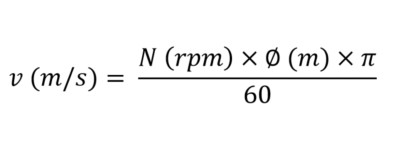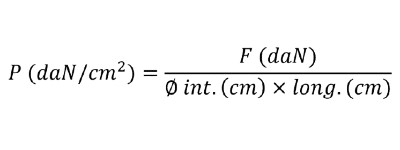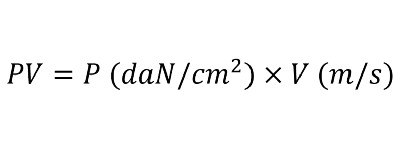Sizing a sintered self-lubricating bushing
Correct sizing of a sintered self-lubricating bushing increases product life and reduces the risk of failure.
Used under ideal conditions, a Metafram ring can last for tens of years.
The strength and life of a self-lubricating bushing depend on 4 major factors:
- The speed of the shaft
- The load on the bearing during operation, it is important to define and calculate it
- The shaft material
- The material of the Metafram sintered bushing
You can find all this information in our brochure
Determination of the shaft speed
Speed is a determining factor in the sizing of a Metafram bushing. In order to be able to determine this speed at the point of contact between the bearing and the shaft, it is important to have the following information:
- N : The speed of rotation of the shaft in revolutions / minute (rpm)
- Ø : The shaft diameter in meters (m)

Material | BG10 | BP25 / BP22 / BP15 / BP10 | BG22 / BG20 | BPV30 | BPV50 / BPV60 | FP18 / SO16 / TR16 | FP20 |
Speed max | 0,5 m/s | 6 m/s | 6 m/s | 6 m/s | 8 m/s | 0,5 m/s | 4 m/s |
Speed min | NA | 0,5 m/s | 0,5 m/s | 0,5 m/s | 0,5 m/s | NA | 0,5 m/s |
Determination of the load on the shaft
The load on the shaft is the second element to be determined for the correct sizing of a Metafram bushing. For this you need to know your application and the force that is applied to the bearing.
On the side of the sinterted bushing, it is important to determine the force exerted on it. To do this, it is necessary to have the following 3 pieces of information:
- F : The load of the shaft on the bearing (daN)
- Ø int. : the internal diameter of the self-lubricating bushing (cm)
- Long. : the length of the self-lubricating bushing (cm)

Material | BG10 / BG22 | BP25 / BP22 / BG20 / BPV30 / BPV50 | BP15 / BPV60 | BP10 | FP20 | FP18 | SO16 | TR16 |
Load max | 75 daN/cm² | 100 daN/cm² | 175 daN/cm² | 175 daN/cm² | 225 daN/cm² | 500 daN/cm² | 600 daN/cm² | 750 daN/cm² |
Determination of the PV
Speed and load multiplication is essential for a sintered self-lubricating bushing. The higher the load, the lower the speed must be to preserve the Metafram ring and vice versa.
This multiplication is calculated very easily with the product of the speed and the load:

In the table below the max PV for the materials of the Metafram range:
Material | BG10 | BG22 | BP25 / BP22 | BG20 | BP15 | BP10 / BPV30 | BPV50 | BPV60 | FP18 / SO16 / TR16 | FP20 |
PV max | 8 | 15 | 18 | 20 | 25 | 30 | 50 | 60 | 9 | 18 |
Find the shaft that matches the sintered bearing
The last parameter to consider when choosing the sintered self-lubricating bushing is the shaft. While respecting the operating clearances stated in the brochure, the shaft must have a defined roughness and hardness depending on the material of the Metafram bearing.
A shaft that is too hard, with a high roughness, will prematurely deteriorate the bearing. Conversely, a shaft that is not hard enough will wear out on contact with the bushing, it is generally better to wear out the bearing rather than the shaft because it is easier to replace.
Below are the characteristics of the recommended shaft :
Metarial | BPV50 / BPV60 | BP25 / BP22 / BP15 / BP10 | BG22 / BG20 / BG10 | BPV30 | FP20 | SO16 | FP18 | TR16 |
Roughness max. (µm) | 0,3 | 0,6 | 0,6 | 0,6 | 0,2 | 0,2 | 0,4 | 0,3 |
Hardness min (HB) | 225 | 250 | 250 | 250 | 350 | 350 | 350 | 375 |
Make the right choice for your Metafram self-lubricating sintered bearing
Ultimately, for a good use of the bushing, all the conditions listed above must correspond with the specifications. Speed, load, PV, shaft, all of these contribute to the proper functioning of the Metafram bushing.
If in doubt, it is always best to contact the Metafram design office for sizing according to your application.
